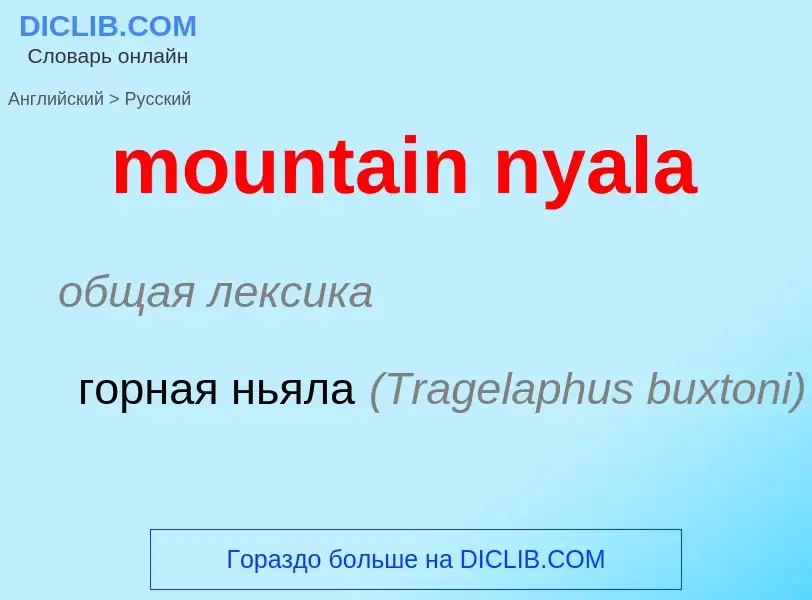Перевод и анализ слов искусственным интеллектом ChatGPT
На этой странице Вы можете получить подробный анализ слова или словосочетания, произведенный с помощью лучшей на сегодняшний день технологии искусственного интеллекта:
- как употребляется слово
- частота употребления
- используется оно чаще в устной или письменной речи
- варианты перевода слова
- примеры употребления (несколько фраз с переводом)
- этимология
mountain nyala - перевод на русский
общая лексика
горная ньяла (Tragelaphus buxtoni)
нефтегазовая промышленность
горная система
Определение
Википедия
 male.jpg?width=120)
The mountain nyala (Amharic: የተራራ ኒዮላ) (Tragelaphus buxtoni) or balbok, is a large antelope found in high altitude woodlands in a small part of central Ethiopia. It is a monotypic species (without any identified subspecies) first described by English naturalist Richard Lydekker in 1910. The males are typically 120–135 cm (47–53 in) tall while females stand 90–100 cm (35–39 in) at the shoulder. Males weigh 180–300 kg (400–660 lb) and females weigh 150–200 kg (330–440 lb). The coat is grey to brown, marked with two to five poorly defined white strips extending from the back to the underside, and a row of six to ten white spots. White markings are present on the face, throat and legs as well. Males have a short dark erect crest, about 10 cm (3.9 in) high, running along the middle of the back. Only males possess horns.
The mountain nyala are shy and elusive towards human beings. Four to five individuals may congregate for short intervals of time to form small herds. Males are not territorial. Primarily a browser, the mountain nyala may switch to grazing occasionally. Females start mating at two years of age, and males too become sexually mature by that time. Gestation lasts for eight to nine months, after which a single calf is born. The lifespan of a mountain nyala is around 15 to 20 years.
The typical habitat for the mountain nyala is composed of montane woodlands at an altitude of 3,000–3,400 m (9,800–11,200 ft). Human settlement and large livestock population have forced the animal to occupy heath forests at an altitude of above 3,400 m (11,200 ft). Mountain nyala are endemic to the Ethiopian highlands east of the Rift Valley, between 6°N and 10°N. Up to half of the total population of the mountain nyala occurs in the 200 km2 (77 sq mi) area of Gaysay, in the northern part of the Bale Mountains National Park. The mountain nyala has been classified under the Endangered category of the International Union for Conservation of Nature and Natural Resources (IUCN). Their influence on Ethiopian culture is notable, with the mountain nyala being featured on the obverse of Ethiopian ten cents coins.

 male.jpg?width=200)

![Taxidermied specimens at the [[American Museum of Natural History]] Taxidermied specimens at the [[American Museum of Natural History]]](https://commons.wikimedia.org/wiki/Special:FilePath/Mountain Nyala diorama (21982315228).jpg?width=200)
 female.jpg?width=200)
 juvenile.jpg?width=200)
.jpg?width=200)

![Male, two weeks old<br/>[[Tswalu Kalahari Reserve]], [[South Africa]] Male, two weeks old<br/>[[Tswalu Kalahari Reserve]], [[South Africa]]](https://commons.wikimedia.org/wiki/Special:FilePath/Nyala (Tragelaphus angasii) young male 2w.jpg?width=200)

.jpg?width=200)





![The [[Andes]], the world's longest mountain range on the surface of the Earth, have a dramatic impact on the climate of South America The [[Andes]], the world's longest mountain range on the surface of the Earth, have a dramatic impact on the climate of South America](https://commons.wikimedia.org/wiki/Special:FilePath/Andes 70.30345W 42.99203S.jpg?width=200)
